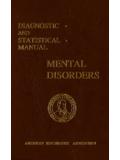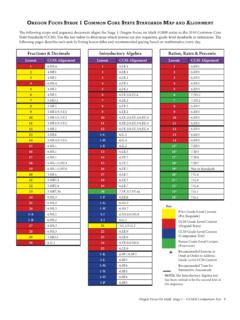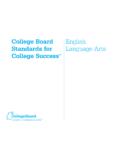Transcription of MARSHAL F. FOLSTEIN, SUSAN E. FOLSTEIN PAUL …
1 J. gsychiaf. Res., 1975, Vol. 12, pp. 189-198. Pergamon Press. Printed in Great Britain. MINI-MENTAL STATE A PRACTICAL METHOD FOR GRADING THE COGNITIVE STATE OF PATIENTS FOR THE CLINICIAN* MARSHAL F. FOLSTEIN , SUSAN E. FOLSTEIN and PAUL R. MCHUGH Department of Psychiatry, The New York Hospital-Cornell Medical Center, Westchester Division, White Plains, New York 10605, and Department of Psychiatry, University of Oregon Medical School, Portland, Oregon 97201, (Received 17 December 1973 : in revised form 25 November 1974) INTRODUCTION EXAMINATION of the mental state is essential in evaluating psychiatric Many investigators have added quantitative assessment of cognitive performance to the standard examination, and have documented reliability and validity of the several clinical tests of the sensorium.
2 2*3 The available batteries are lengthy. For example, WITHERS and HINTON S test includes 33 questions and requires about 30 min to administer and score. The standard WAIS requires even more time. However, elderly patients, particularly those with delirium or dementia syndromes, cooperate well only for short Therefore, we devised a simplified, scored form of the cognitive mental status examination, the Mini-Mental State (MMS) which includes eleven questions, requires only 5-10 min to administer, and is therefore practical to use serially and routinely. It is mini because it concentrates only on the cognitive aspects of mental functions, and excludes questions concerning mood, abnormal mental experiences and the form of thinking. But within the cognitive realm it is thorough. We have documented the validity and reliability of the MMS when given to 206 patients with dementia syndromes, affective disorder, affective disorder with cognitive impairment pseudodementia 5T6), mania, schizophrenia, personality disorders, and in 63 normal subjects.
3 DESCRIPTION OF THE MMS The MMS is shown in the appendix. Questions are asked in the order listed and scored immediately. The tester (psychiatric resident, nurse, or volunteer) is instructed first to make the patient comfortable, to establish rapport, to praise successes, and to avoid *Reprint request to now at Department of Psychiatry and Behavioral Science, Johns Hopkins Hospital, Baltimore, Md. 21205. 189 190 MARSHAL F. FOLSTEIN , SUSAN E. FOLSTEIN and PAUL R. MCHUGH pressing on items which the patient finds difficult. In this setting most patients cooperate, and catastrophic reactions are avoided. The MMS is divided into two sections, the first of which requires vocal responses only and covers orientation, memory, and attention; the maximum score is 21. The second part tests ability to name, follow verbal and written commands, write a sentence spon- taneously, and copy a complex polygon similar to a Bender-Gestalt Figure; the maximum score is nine.
4 Because of the reading and writing involved in Part II, patients with severely impaired vision may have some extra difficulty that can usually be eased by large writing and allowed for in the scoring. Maximum total score is 30. The test is not timed. Detailed instructions for administration are given in the appendix. METHODS The MMS was given to two groups of people that we will refer to as Samples A and B. In Sample A (Table 1) are 69 patients chosen specifically as clear examples of clinical conditions (29 with dementia syndromes due to a variety of brain diseases, 10 with affective disorder, depressed type with clinically recognizeable cognitive impairment, 30 with uncomplicated affective disorder, depressed type) and 63 normal, elderly persons similar in age to the patients. All the patients were tested shortly after admission to the New York Hospital Westchester Division, a private psychiatric hospital and the normal subjects were tested at a Senior Citizens Center and at a retirement apartment complex.
5 Thirty-three of the 69 patients in Sample A were retested after treatment. The patients with dementia were treated according to their clinical conditions. They occasionally received tricyclic antidepressants or phenothiazines as well as treatment for medical illnesses. The patients with depression were treated with antidepressants and/or ECT. They also may have received medical treatments. Sample B (Table 2) is a patient group formed by taking consecutive admissions to the hospital and giving them the MMS shortly after admission. It was intended to be a stand- ardization sample and came eventually to consist of 137 patients (9 patients with dementia, 31 patients with affective disorder, depressed type, 14 patients with affective disorder, manic type, 24 with schizophrenia, 32 with personality disorder with drug abuse, and 27 with neurosis).
6 These diagnoses were made by on review of the hospital chart em- ploying the diagnostic criteria described below and without knowledge of the MMS scores. Subsets of patients from both Samples A and B were extracted for age-matched studies (Table 1B) concurrent validity (Table 3) and test-retest reliability (Table 4). The following diagnostic criteria were used for both Sample A and B: Dementia. A global deterioration of intellect in clear consciousness. Affective disorder, depressed type, with cognitive impairment. A sustained feeling of depression with an attitude of hopelessness, worthlessness or guilt accompanied by dis- turbances in orientation and memory which occurred after the onset of the depression. Affective disorder, depressed type, uncomplicated. A sustained feeling of depression with an attitude of hopelessness, worthlessness or guilt and with no notable cognitive defect.
7 Afictive disorder, manic type. A sustained feeling of elevated mood with an attitude of overconfidence or exaggerated self-importance. Schizophrenia. Either Schneider s first rank symptoms in the absence of affective symp- MINI-MENTAL STATE 191 TABLE 1. Sample A A "ini Mental State Scores on Admission Sex MMS Mann-Whitney __ Diagnosis N Age M/F 7 Rans U P Dementia 29 1207 O-22 45 <.OOl Depresslo" with cognitive 10 713 9-27 Impairment < ,001 Affective Dis., 30 9/21 8-30 Depressed 1178 (Z=6) <.OOl Normal 63 27/36 24-X L Mini Mental Scores O" Admission: Aoe-Matched Sample Age Sex MMS Mann-Whitney Diawvxis N Age Range M/F x Range U P Dementia 8 76 75-79 2/6 1-14 4 < ,001 Depression with cognitive 8 76 513 9-27 Impairment < ,006 Affective Dis., 8 74 69-79 I/7 17-30 Depressed C.
8 Mini Heental State Scores of Patients Tested Before and After Treatment S&K MMS MMS i days Wllcoxon Diagnosis N Age M/F i -i Range P Dementia 14 6/8 n-22 l-19 23 20 NS Depression with cognitive 7 512 13-27 21-26 36 (.025 Impairment Affective 12 3/g 14-30 16-30 51 Depressed <.025 ____- TABLE 2. Smnle 0 SW MMS Diagnosis 11 A"? M/F __ x Ran&_ Dementia 3 ;:.4 3/G l-12 Depression 31 16/:5 9-33 Mania 14 G/8 21-30 Schizophrenia 24 14/10 l-30 Personality 32 17/15 19-30 Disorder with Drug Abuse Neurosis 27 15/I? 71-30 toms or the presence of a personality deterioration associated with thought disorder and emotional incongruence without first rank symptoms. 192 MARSHAL F. FOLSTEIN , SUSAN E. FOUTEIN and PAUL R. MCHUGH Personality disorder with drug abuse.)
9 Absence of all above symptoms with a history of drug abuse, including alcohol. Neuroses. Presence of psychological symptoms appearing to arise from the combination of a particular life situation and vulnerable character but with the specific absence of symptoms characteristic of the other syndromes. TABLE 3. Sample for MNS - IQ Correlation Sex Di agnw 5 N Age I:/!_ Dementia 7 78 314 Depression with cognitive 8 76 6/2 Impairment Depression 8 55 3/s Schizophrenia 2 68 l/l Neurosis 1 22 O/l TILE 4. Tes:-Retest Rcliablllty Type of Sample X days Irilcoxon MMS 1 K,S 2 between T P Pearson Reliability aposition N Aqe Sex i Ranqe Range tests (2 tail) I P 24 hr. hi/l various types retest of depressive 22 3/19 Z-30 (1 tester) l-30 1 45 NS symptoms <.OOOl 24 hr. various types retest of depressive 19 7112 13-30 13-30 1 22 NS (2 testers) symptoms <.
10 OOOl 28 day dementia, retest depression, clinically schizophrenia 23 6/17 l-30 1-29 42 NS stable <.OOOl patients Validity RESULTS The MMS separated the three diagnostic groups in Sample A from one another and from the normal group. Of a total possible score of 30, the mean score for patients with dementia was , depression with cognitive impairment , and uncomplicated affective disorder, depressed The mean score for normals was Thus, the MMS scores agreed with the clinical opinion of the presence of cognitive difficulty and as the cognitive difficulty is usually less in depression than in dementia the scores dispersed in a fashion agreeing with the severity of the difficulty. To be sure that these scores were not due to age effects and unrelated to clinical con- ditions an age-matched group was drawn from Sample A and showed an identical dispersal of scores according to diagnosis (Table lb).






